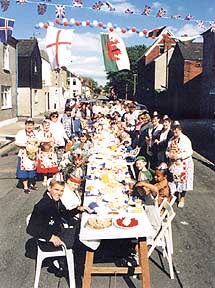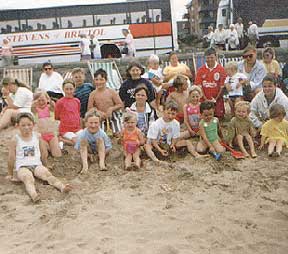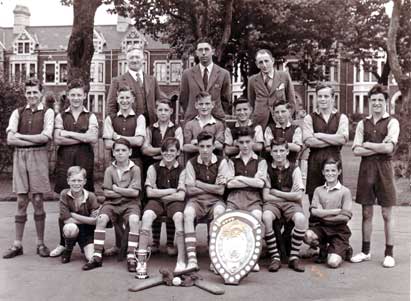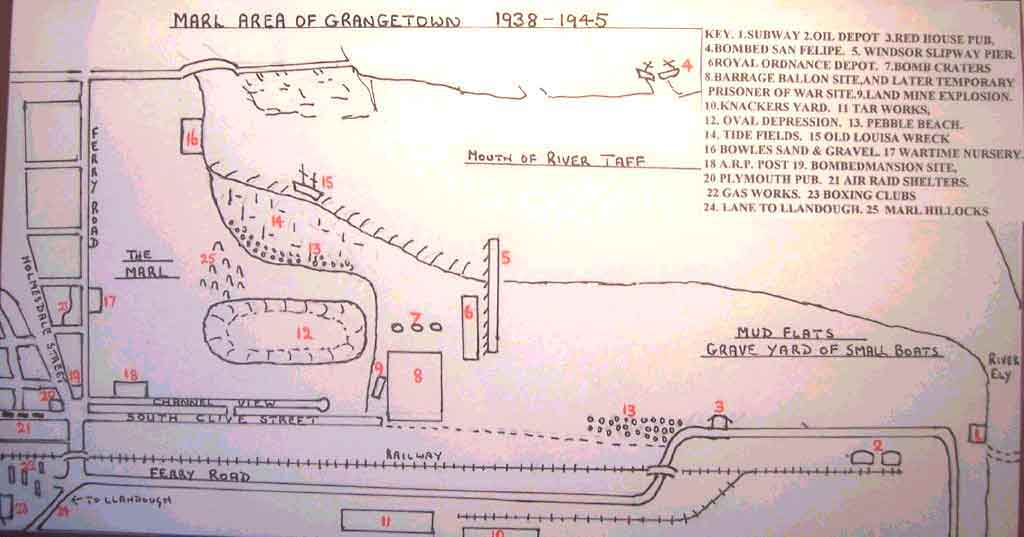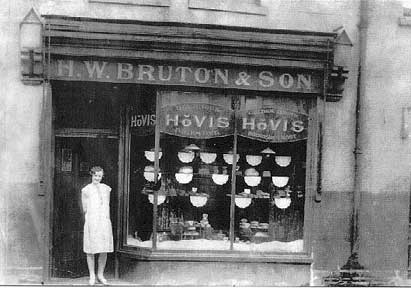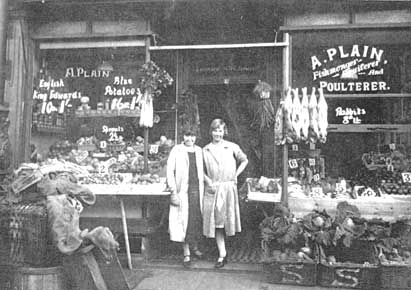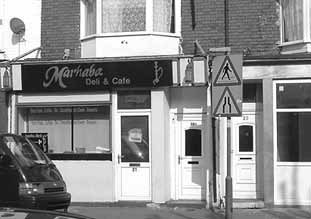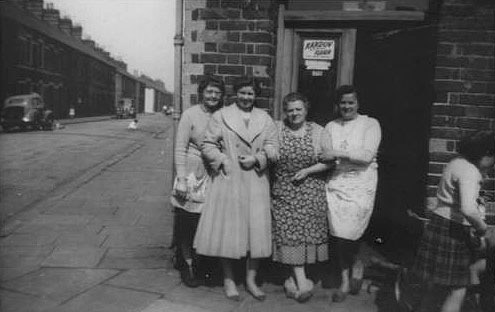
PART THREE: Here is Grangetown history covering memories from the 1940s and 1950s onwards, including schooldays. Please email us with any stories, memories or photos. Return to Part One or Part Two
Nature alongside the Taff and Rhymney
By Jack Payne
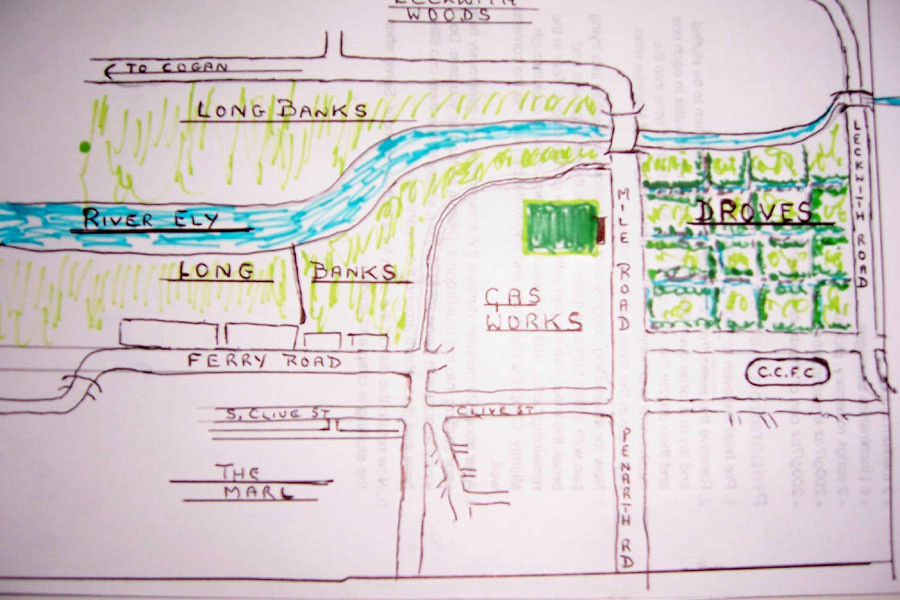
When I was a young lad I used to collect
birds eggs, consequently I knew the countryside within and around Grangetown
like the back of my hand.
Sadly, most, if not all of this countryside as I knew it, has now disappeared.
There was a large area to the left of the Mile Road bordering the River
Ely known as the Long Banks. This area of lush grass was once tide fields
but unlike those bordering the river Taff, which was criss-crossed with
gullies which filled when the tide came in. This area only had one gully
leading from the Tar and Oil Works in which nothing lived at the bottom
and the sides were caked with black oil.
The Long Banks themselves differed. The Lower Grangetown side had no easy
access because of the factories bordering Ferry Road. Access could only
be gained from the top end of the Gasworks Lane. Because of this inaccessibility
and the fact that the river no longer flooded this area, it was a haven
for wild birds breeding. Over time I collected snipe, lapwing, sandpiper,
dunlin, redshank, curlew and skylark eggs in this area. The opposite side
of the Long Banks had cattle and sheep grazing all year round, so consequently
with the exception of the skylark it was not a nesting site.
The other area of importance to wildlife was The Droves located between
the Mile Road and Leckwith Road.The Droves consisted of numerous grass trackways
with ditches and hedges on both sides forming borders for small fields.
One must suppose that in medieval times by its name it was used for droving
horses and cattle. Wildlife of all kinds were in abundance: Rabbits, hares,
foxes, pheasant, partridges, moor hens, coot, wild duck and close to the
Cardiff football stadium (Ninian Park) was a marshy area with very large
flat stones under which could be found frogs, toads and small lizards. At
the Leckwith end was a permanent Romany Gypsy encampment, where you could
see them sitting around a fire making clothes pegs and flowers from wood
taken from the hedgerow.
1950s: School days - baby boomers, 'Basher' Beynon and the G stream
By Ken Payne
Another memory of the Nash is the open fireplaces in all the classrooms.There
was no such thing as central heating. A coal fire behind the teacher was it.
In the winter time the bottled milk would be placed around the fireplace to
warm. When it was time for your milk break the teacher would ask questions,and
the first person with right answer would get the chioice of the warmest milk.
Again looking back it amazes me that no one got scalded or injured in these
everyday events.
Every week there was one afternoon dedicated to sport.The class would be put
in pairs in the playground, the most trustworthy at the front and the rear ,the
not so reliable near the middle of a line formed by the pairs. We were always
instructed to hold your partners hand as we walked. We would then go out the
school gates and walk down Clive Street to the junction with Holmesdale Street
and Ferry road.we would be seen across the road by the teacher,and then on to
the Marl playing fields. Here we were separated into group - boys and girls,
athletic types and not so athletic.The athletic boys would be organised into
football or baseball teams,or even into running events.The girls would also
play baseball or be given other exercises to do. The remainder,not so athletic,
would be made to walk circuits around the perimeter of the park until it was
home time.
At home time you were left to your own devices as how to get home, easy for
me as I lived right by the Marl. School in those days started at 9am,with a
playground break at approx 10.30am for 15 minutes, then dinner was from noon
till 2pm. Afternoon break was at 3.15 pm then the schoolday finished at 4.30pm.
I went home every day for dinner (no such thing as lunch) as did most
of my friends. It would be a quick meal and then out playing with my mates till
it was time to go back to school.There was no gymnasium at the Nash so the PE
classes would be in the playground (weather permitting). There was no such thing
as gym kit -you did your exercises in whatever you wore to school. Great fun
though. In the playground as we got older was where we learned to play “strong
horses". This involved three or four boys going up against the wall and making
a formation. The rest of the boys would then proceed to vault on to their backs,endeavouring
to land as hard as possible, until the formation collapsed in a heap of arms
and legs. The team holding the most boys being the winners.
Also there was whiplash: This
is where you formed a line, and all held hands. The biggest and strongest acted
as the centre point, he would start rotating round and round,the boys on the
outside of the line would eng up running full pelt until they let go or fell
over. I tried this in later life during football training exercises, and it was
really difficult to stay on your feet. The wall along the side of the playground
backed on to Clive Street police station, the holding cells right next to the
wall. I remember now expecting to see prisoners with arrows all over their clothes, a
general perception of criminals. The teachers seemed to be quite well known to
your parents and were given great respect. If they said or did something it must
be for your benefit, the teacher was always right. The school headmaster was
Mr Fred Parkin who was quite strict. I can recall "mitching" off school with
my brother to watch England play Wales on a Wednesday afternoon. We had just
got our first black and white television, and the game was on. However word got
round that we were watching the match, and six or seven other boys turned up
at our house to watch it. This was fine until school the following day, we all
had our excuses ready,however the first boy they asked why he was off school. "I
was round Kenny Payne's house watching the football" came the reply. Boy after
boy then relented and said they were at our house. The end result was six of
the best for me and my brother in front of the whole school. Painful memory.
I was now at the age to sit the dreaded 11 plus, which I passed. This meant a
change of schools though I really didn’t want it. Some of the boys who passed
decided to stay at the Nash, while others were drafted to various schools around
the area - Fitzalan, Canton High, Cardiff High for example.
I was selected to go to Ninian Park School on Sloper Road. Here the Council
had implemented a new system called the "G" stream. Because of the high number
of passes there wasn’t enough room for all at the High Schools, so this was
an additional class to take you through to O'Level. Looking back I think we
were used as a test to try the system. The boys that made up the “G” stream
came from several different areas. There were about 15 from Ely, 10 from Canton,
six from Riverside, the rest from Grangetown, making a class of 38.
I still recall the monotone reading of the register
every day: Appleby, Bolton, Bridges, Capel, Corsi and so on. This new school took
some getting used to for this class. For a start we were all strangers to each
other. Also we were the only class that had to wear uniform,a system that for
a while alienated us from the rest of the school. The rest of the boys in our
age group being put into three different class groups, A, B and C. The theory being
that the brighter members of the A class could graduate into the "G" stream, and
the other boys go up and down the classes depending on their ability. There was
in total upwards of 120 boys of the same age spread over these four classes. The
other thing I think about is the teaching. The same teachers taught all four
classes, so their range of pupils were in the extremes,not something you would
get at a conventional high school. At first we were the "posh" kids because
of the uniform, but eventually we were accepted as just pupils in the same school. Discipline
at this school was much tougher,some of the teachers had reputations to hold. Basher
Beynon, maths teacher, Moggie Slater P.E teacher, "Spud" Reynolds history teacher, were
a few that would give you the cane at the first excuse. However there were compensations, such as the
sports side of the school, which was excellent. Ninian Park prided itself with the accomplishments
of the soccer and baseball teams. The intermediate team was run by Mr Gough, the art
teacher,who had the uncanny knack of producing a team - a side that played as
a unit. I had the utmost respect for Mr Gough and my involvement with the football
team helped my integration into the school. Football games were played on Saturday
mornings in those days. We would have a team meeting Friday dinnertime to make
sure all the boys were available (I was never ill on a Friday), you were then
issued with your school football shirt. There was no such thing as substitutes
in those days,so it was ten outfield shirts and a goalkeepers jersey,and everyone
was expected to turn up,otherwise you played with what you had. Away games were
organised at these meetings,we would make our way to the central bus station
individually, here we would meet Mr Gough outside Asteys. Then it would be a bus
trip to Whichurch,Llanrumney or which ever district we were playing. We had to
provide our own bus fares,there was no school funding for this. After games we
would catch the bus back to the Central Station,and then make our own way home. One
of the benefits of playing for Ninian Park,was the occasional free pass to watch
Cardiff City on Saturday afternoons. We were a very successful side going through
the season winning all games,doing a league and cup double. We also managed to
win a "Tiger" football - this was the comic that introduced Roy of the Rovers to
the nations schoolboys. They had a monthly award for the most successful teams
at intermediate level, age 11 to 12, which the school team won. I thoroughly
enjoyed my football experiences in school, and still see some of the old players
around Cardiff. Classwork at the school was a different matter though. I struggled
with the change of teaching, the different classmates,and the homework. Whilst
at the Nash I hadn’t done any homework. This new intrusion on to time out of
school was difficult, especially as all my mates at the Nash wasn’t doing any. Also
at Ninian Park I was average at most things where at the Nash I was one of the
brighter pupils. This all made me struggle with the classwork. I wasn’t alone
with this as the majority of my new classmates seemed to be in the same boat. Obviously
some of the boys prospered and coped better than others but on the whole a lot
of us were not happy with our classwork. Disruption in the class was rife with
lots of misdemeanors and general bad behaviour. I’m sure looking back that the
root cause of all the problems was the size of the class. I’m convinced that
the class should have been split in two and therefore give each pupil more time
with the teacher. However I battled through school lessons and achieved some
level of success in exams, but not what I would have liked to achieve.
I think now that my own appraisal of those days is could and should have
done better. In general though I can look back and say I enjoyed the majority
of my days at school.
Being born in 1947, I was part of the baby
boom after the end of World War II. Having done a little research with friends
I can safely say that the average class size throughout my term in school was
approx 38 pupils. Starting off in Grange National (The Nash) as a five year
old, where you spent your early years in the infants. The head mistress was
Mrs Macarthur, I can also remember a Miss Lewis.Those early years seemed tc
consist mainly of play, sleep and story telling. Reading, spelling, times tables
and mental arithmetic were all to follow.One thing that strikes me now looking
back, is the order in the classroom,with in the region of 40 pupils in the class,the
order was immaculate with only one teacher. Consequently with that size class
some prospered and some fell behind. I can distinctly remember the class being
sorted so that the brighter pupils sat next to the slower learners. The object
was to encourage the slower learners to get help and encouragement off their
peers.I don’t know how successful the system was but it certainly was employed
as an aid to the teacher. 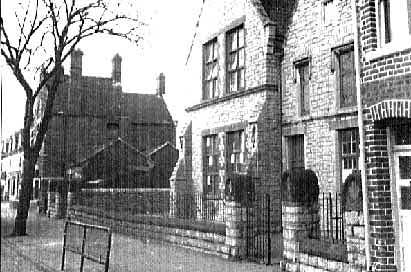
"The Nash" school was next door to Clive Street Police Station.
1950s: School days - spare the rod, spoil the child
By Graham Goode
Unlike the restrictions placed upon parents and teachers today the maintenance of discipline in the classrooms and sometimes in the homes seemed to be based upon the Biblical dictum: spare the rod and spoil the child. Mam could and did infrequently resort to using a wooden spoon to bring me to order if I was were overstepping her generally tolerant responses to boyish behaviour.
My Dad, on one occasion I remember, took me over his knee and strapped my backside with the belt he wore to keep up his trousers. This happened despite the protestations of my mother as, "He needs to be taught not to let good food go to waste." It was the custom on a Sunday for Dad to cook the Sunday dinner ('lunch' was for the posh). Proud of his organic gardening the wide range of vegetables were cooked and served. Inevitably I baulked at eating cabbage and on this occasion I declined to clear my plate. "Too many sweets before a meal," was the usual reason put forward by adults for children turning up their noses to good wholesome fare. But the continuing rationing of sweets and chocolate hardly allowed for confectionary bingeing. So the remains of the meal were served up at the next meal but I had refused to, 'clear my plate.' Exasperated, my father applied the belt with gusto and I found it more comfortable to stand awhile before being sent to bed without supper.
This was a rare occurrence for me although my brother testified to many more corrections of that kind and at a time when Dad had even more energy to lay on the strap.
I now eat cabbage without a murmur.
A slap across the backside or a clip across the ear was sometimes used to rein in any of my obstreperous behaviour. No hard feelings developed. The punishment was dished out and taken without harping on the degrees of justice or injustice that had occurred.
Generally I accepted it
as such. School was a different kettle of fish. My local school was originally
built as a Board of Education School maintained by the Council at the end of
the nineteenth century. It was inevitably referred to as 'The Council' as opposed
to the nearby Church or National School of about the same age which was always
called the 'Nash'. In the 'Infants' the teachers were all women and the classes
were a mix of boys and girls. There was just one vivid memory of a lady teacher
taking a girl in our class across her knee to apply a slapped bottom. We boys
were keenly interested in this event as we felt ourselves to be positively discriminated
against in terms of corporal punishment. A girl about to be disciplined in this
way was unique in our experience and I would like to think it was this uniqueness
which was the cause of our keen observance of the event. But I believe it was
the method of administering the punishment which captured our rapt attention,
for the teacher, an otherwise kindly grey haired lady, proceeded to lift the
girls skirt to reveal a rather worn pair of faded and stained black knickers
with a hole in them. The slight protuberance of pink skin through the hole and
this unsolicited glimpse under a girl's skirt caused a collective intake of
breath rendering us seven year olds helplessly trying to contain breathless
mirth at this unfortunate girl's misery as she endured a slapped bottom. In
the time honoured way of countless generations of heartless schoolchildren the
poor girl was for a long time subject to catcalls of "old peepy pants" - either
from our seeing part of her bottom peeping out of her drawers or a general reference
to their staining. The passing of water in a deliberate fashion did lead me
and several of my friends into the kind of trouble we were definitely not keen
to be communicated to our parents. Receiving any punishment at school was not
to be broadcast by one's self because it usually led to a supplementary slap
by parents who generally believed that the standards of the school reflected
the standards of the home in terms of behaviour or that was the general impression
given. I tended to believe that the behaviour at school warranting the physical
punishment was considered to impinge on the honour of the family in some way
- like the Samurai of the comic books it may have been more honourable to commit
hari-kari rather than admit to the incident which led to our public humiliation
in front of the whole Infants school. It was a particularly nasty schoolmate
who split on his or her friends by bellowing the misdeed and punishment out
as they passed your mother hanging washing on the line. It would, of course,
have been poetic justice if old peepy pants had spilled the beans. This particular
incident was really down to the teachers who, believing in the virtues of self-constraint
refused to let us go to the toilet during lesson times. After all, "Break times
were for those kinds of personal matters." This was in direct contradiction
of the belief of active young boys. Why should we waste precious break times
on the mundane matters of relieving ourselves and thus forfeit the chance to
be in the thick of the playtime hurly burly? This particular day the period
between morning break and lunchtime seemed to drag. Not coming from the Land
of Big Bladders my friend and I were dying to go to the toilet. Kept back for
a few minutes to aid the teacher in some clearing up task we danced about, were
admonished for not going at playtime and finally let free. We hared across the
playground to the only toilets heading straight into the boys' urinal. There
we met with two or three other boys much practised in the art of relieving themselves
in intermittent jets of urine in the same manner as the explosive spurts of
water obtained by squeezing the end of a hosepipe. We joined in blasting the
urinal wall clean of any algae but then raised our sights higher. Now the Boys'
Toilets were red brick built with a sloping roof. Between the roof and the wall
which was about six or seven feet high there was a gap of about two feet presumably
to allow fresh air to ventilate the toilets. It was a sunny spring day and the
girls had the habit of talking, and eating their sandwiches whilst sitting in
the playground leaning against the southward facing walls of both boys' and
girls' toilets. Others tucked their skirts into their knickers and perfected
handstands against these walls. The temptation was too great to resist. We stood
back and directed our jets at the inviting gap. The reaction of the girls was
not immediate as the spots of 'rain' were at first, far from torrential. As
our aim improved so did the deluge and it suddenly dawned on our unfortunate
victims that this was not due to the usual vagaries of the weather. Screaming
with disgust they charged into a teacher on duty, who, seeing the by now dwindling
streams of water dribbling down the outside of the toilet wall, marched unabashed
into the urinal. To be caught in delecto was as frightening as to be caught
at all. The only females to have clapped eyes on our intimate boyhoods were
our mothers or inquisitive sisters. The outraged young lady teacher drove us,
fumbling with our flies, across the yard to the headmistress's office. The trails
of our offence were carefully avoided by gloating boys and girls who flocked
behind us to the school entrance. Ears and rears burning we were tongue-lashed
in front of the whole Infants school and suspended from lunchtimes for two weeks.
Our parents were supposed to be appraised of what was a capital offence and
to foot the laundry bill for the girls' dresses. We kept quiet about it. Strangely
the school did not kick up an almighty fuss - maybe there was no desire for
an admission that supervision of the yard was deficient in that respect. For
a fortnight we subsisted on next to nothing at lunchtimes as we met in the nearby
park passing the time as inconspicuously as possible trying to ignore the resultant
stomach pangs and hoping our parents would never find out. Being the 'top dogs'
of the Infants we experienced none of the kind of taunting meted out to old
peepy and the squatters' rights of the girls to the sunnier side of the playground
were irretrievably forfeited much to the delight of some of the boys who admired
and, I gather, tried to emulate our celebrated bladder control.
To move from the Infants' to the next stage of education - on the same campus
- was something of a shock. The education system was under historic review as
a result of the Butler Act of 1944 and the stages of schooling were about to
be redefined as primary (which could be further subdivided into Infants and
Juniors) followed by secondary schooling of either grammar school for about
15% of the school population or secondary modern school for those who did not
pass the entrance examination known as the 'scholarship' to go to grammar school.
At the time I moved up into the 'junior' stage of my education that part of
the school was still being run as a boys' elementary school where boys between
the ages of seven and 14 received their education.
Upon reaching 14 years of age they left school to take up occupations mostly
in the skilled apprenticed trades or other, unskilled, work. Careers in the
professions and further education tended to be the prerogative of grammar school
pupils who stayed on at school usually until the age of 16. Within two or three
years the changeover would be complete - the remaining 14 year olds had moved
into the wider world and the junior school was inhabited by seven to 11-year
olds. It was during the intervening years of the changeover that I found myself
like all the other seven year olds to be the small fry in a sea of big fish.
All the teachers I came across in the 'junior' stage of my education were
men many of whom had endured life in the trenches of the First World War and
some had served in WWII. They had been young men 'under discipline' and some
seemed to want to impart this experience to their charges with liberal use of
the cane for any and every transgression in and out of school if the latter
came to their notice. They were both feared and respected. If you can imagine
the pressure they must have been under to control classes of boys as large as
40-50 pupils sitting in rows of desks as well as facing change which proved
difficult for some to accept it was no wonder that patience was at a premium.
The cane ruled supreme. This was not to suggest that we lived in constant fear
- in fact, the earlier experiences of physical discipline had in some ways inured
us to the fear of corporal punishment. True, it was best avoided and unpleasant,
but the pain was no worse than having your teeth drilled and filled without
anaesthetic by the glass-eyed Scotsman who masqueraded as a school's dentist
in the nearby newly instituted National Health clinic. As well as being the
sincerest form of flattery imitation is also a great tool of learning.
So it did not take long for us small fry to pick up the requirements of the
almost military discipline which attended our learning and movement about the
school. When the whistle was blown by the teacher on duty in the yard at five
to nine we stood stock still and then formed up in twos in our classes on the
next whistle. The 14-year olds marched into the main entrance and keeping in
step to the commands of, "Left, right, left, right," they marched up the several
flights of well worn stone steps to the top floor. The rest of the school wheeled
about in their forms (known as standards) to follow on in descending order of
age. It was usual for each standard to mark time at the foot of the stairs marching
on the spot and increasing the foot worn indentation in the slab of Welsh slate
that fronted the doorway. It was always an orderly entrance, all in step, and
wheeling left or right into the appropriate classrooms for registration. It
took no time at all to feel a certain pride in being part of such a regimented
system of movement - after all we had been brought up on stories of wartime
service and here we were aping what we thought were the smart barrack square
gyrations of our fathers and brothers. I say it was always an orderly entrance
but I do remember a time when, caught short just as the whistle went, I marked
time with my class of seven year olds only to have the abject humiliation of
noticing and being noticed that my army surplus short trousers were giving off
a strong smell and feeling distinctly uncomfortable. In the kind of humane gesture
reserved for the putting of horses and dogs out of their misery the duty teacher
pulled me out of line and sent me home to change my soiled pants. I was not
the only little boy to have this experience. We just did not have the gumption
to interrupt the clockwork precision which attended the beginning of the school
day. Besides, school toilets were no longer my forte. About the only time I
can remember a teacher offering what might have been interpreted as an apology
for giving me the cane was when I could not stand still in line when he was
addressing me. The conversation, conducted in one-sided decibels went something
like this: "Stand still when I'm speaking to you boy!" "I am standing still
Sir." "You are distinctly moving. Do you have St. Vitus' dance?" "My sisters
like dancing Sir but I haven't learnt yet." "You are being impertinent (I did
not know the meaning of this word any more than I knew who St. Vitus was but
his clipped pronunciation gave me his drift) and you are not standing still."
"But Sir I am standing still it's my shoes." This was too much for him. I put
out my hands as ordered and was promptly caned (we called it 'cut') across both
palms. Gripping both open hands under my armpits in the time honoured way of
relieving the sting I rocked not so much with pain as with the unbalanced movement
of my soles. The distress on my face must have prompted the teacher to inquire
about the relationship between my shoes and my inability to stand stock still.
My closest school mate tried to help. "His shoes are tired Sir." Well, what
he said sounded like 'tired' but it could hardly have been pronounced in any
other way because he knew that, in the ways of so many make-do and mend fathers,
the soles of my shoes had been 'tyred' that is reshod with strips of bicycle
tyre. Stretching and nailing the tyre pieces to the soles could never quite
remove the rounded part of the tyre which lay lengthwise along the soles and
it was this that made it nigh impossible to keep your feet firmly on the ground
and induced a sideways rocking motion. The teacher, broke off from upbraiding
my pal about the absurdity of insomniac inanimate objects - a reference to shoes
and to him - and both exasperated and curious, ordered me to show him the soles
of my shoes. I gingerly gripped one ankle and, hopping uncontrollably on the
spot, smarting from the cuts across my hand, rocked on one foot to show him
the evidence of my Dad's workmanship. He actually hooted with laughter, called
another teacher across but then, unbelievably, told me to congratulate my father
on his initiative and said he might be able to supply tyres from his motor bike
to improve my situation. On top of this back-handed compliment he said he may
have acted a little hastily in his use of the cane but in any case I should
have known who St. Vitus was and thus avoided the stupid remark about my sisters.
The free use of the cane was a harsh motivator. I learnt who St. Vitus was and
many other more useful things like chanting the arithmetic tables from twos
to thirteens without error in order to avoid the cane. At least once a week
the whole school assembled for table chanting. At least that's what we called
it. The headmaster called it arithmetical aptitude. We all had to have arithmetical
aptitude otherwise life would be a closed book to us. Many unfortunates did
not even have a closed book to call their own. They were usually kept down a
standard for lack of aptitude in the teachers' terms. This meant that some standards
contained a few poor souls who had not reached the 'standard' for their age
and were kept down a year. Most of the teachers had given up flogging a dead
horse let alone their hides and hands and they were condemned to be the 'hewers
of wood and drawers of water' as I learnt in one assembly with a hint of religious
flavour. Yes, I had witnessed boys being caned for getting the answer wrong
to such questions as, "What is the product of seven and six? (No answer from
the victim) I shall rephrase that: what are seven times six? This of course
is the same as six times seven." Seeing the myriad of upraised hands in the
assembly all straining to show their arithmetical aptitude the unnerved pupil
stammered out an answer which was inevitably wrong because the head had chosen
a boy who had failed this interrogation last week. A public caning usually of
one or two strokes resulted. In my imagination I could see that at some time
the victims would be seized up to the blackboard and the cat o' nine tails taken
from its bag and applied 42 times across the unfortunate miscreant's back. If
such displays of corporal punishment were intended to encourage the others they
certainly had some effect on accelerated rote learning. One incident that has
stuck in my mind took place in my final year of junior schooling. Having been
warned several times for talking out of turn by my scholarship class teacher
I was called to the front of the class to be caned for persistent chatting.
I hasten to add that I really liked this teacher (Mr Stan Stuckey) who was one
of the old-stagers and had an enviable reputation at getting his pupils through
the scholarship. It was my second year in his class as I had been promoted a
standard (yes you could go up as well as down in this system) at nine years
of age but had been too young to sit the grammar school entrance exam the previous
year. He stood no nonsense but seemed to be all too aware that his pupils, who
were by then a mixture of primary school boys and girls, were the crème de la
crème in a district school which still found that grit could be turned into
pearls. Taking his avuncular mien somewhat for granted I had tried his patience
once too often. It was a wintry day and the caretaker of the school had lit the
coal fires which still existed in most classrooms. The teacher took the cane
out from behind his blackboard and flexed it for use but the ends of the cane
were flayed into strips. To add insult to impending injury the teacher told
me to put my coat on, gave me a tanner (not the cane itself but sixpence!) and
sent me to the local shopkeeper who provided the school with canes. This corner
shop had cornered the market in these instruments of torture and a further twist
was that the shopkeeper still nurtured an outstanding debt from my mother who,
like everyone else, had several grocery items 'on the slate' until payday. Seeing
me shopping in the middle of the school day caused him to remark, "It's good
to see your mother has given you a special errand to pay off what is owing."
Taken aback I blurted out that it was Mr Stuckey at the school who had sent
me to buy a cane for him I added that I was to be the first recipient of its
favours. The disappointment at non-settlement of my mother's bill was replaced
by a wide grin as compensation for my lack of financial fruitfulness. He brought
to the shop counter a rather apt cane basket containing a variety of more lethal
canes. With deliberate and dramatic painstaking he selected and rejected several
canes remarking that Mr. Stuckey liked greater flexibility and length or that
he liked a more open hooked handle. He lovingly explained that Mr C. another
teacher of more sadistic bent preferred the short stubby thicker version, that
Whacker W. preferred a stiff rod-like one and Basher B. liked a thinner, whippier
variety. Generations of schoolchildren including my own father would testify
that, of all the teachers, Mr C. was universally feared when on yard duty. He
carried his short, stubby cane, about the thickness of an adult thumb, in his
coat pocket so that about nine inches protruded on show to all who passed near
him. It was particularly painful to be rapped across the knuckles with it or,
even worse, cut across chilblained hands in cold weather. My father who attended
the same school once told me that after doing this to one young boy during the
first War the boy's older brother, on leave from the Navy, stormed into Mr.
C's classroom and floored him with one punch for, "Splitting our kid's chilblains
with his bloody stick." This rather direct intervention may have had a salutary
effect for a while but by the end of his career he was still wielding his stick
with the same old relish. At last the shopkeeper chose what he called, "The
right kind of cane for old Stan," made an ominous swishing noise as he clove
the air with it, took the proffered sixpence and hoped it would repay his careful
selection for the teacher. I left the shop with the cane carefully wrapped in
brown paper but with the crooked handle left uncovered. There was still about
an hour to the end of school and there was no way I could justify a 10 minute
walk from school had taken all of 60 minutes. There looked like no chance
to delay the inevitable but, perhaps an outside chance that I could be waylaid
and my oddly wrapped piece of shopping forcibly taken from me came to mind.
Rather than walk back by the main road and streets leading to the school I would
take the ever present lanes - those alleyways of noisy games playing and the
alien territory of gangs based in the houses that shared these common routeways.
For once, the Boardie must have had an impact or the cold weather had curtailed
operations for the rival gang members who may all have been in school. I returned
to school unmolested by older boys of the Dick Turpin kind and wondering where
there was a footpad when you most needed one. On entering the classroom there
was a solemn hush. The ritual would begin. The sacrificial lamb had arrived
bearing the rod of atonement. My hands were cold, my tongue dry and my sphincter
muscles tensed. Old Stan unwrapped the cane in a way that suggested he was about
to whisper endearments to a willowy mistress but instead he thrust the end into
the glowing embers of the fire. This sudden and unexpected turn of events gave
me a glimmer of hope that Mr S. had seen the light and was to eschew the ways
of physical correction for eternity. Fat chance. Removing the tip of the cane
from the fire he snuffed out the singed end with his sausage like fingers. Ever
keen to impart knowledge old Stan explained to me and, by implication the attentive
class, that by carrying out this procedure he had hardened the tip of the cane
to reduce the chances of it splitting in the way his previous implement had
done. So the gods of the fire could have saved me my errand of tribulation.
The cane duly cauterized, Mr S. magnanimously gave me the choice of having it
struck across my hands or my backside. No good pleading mitigating circumstances
and partial redemption by being an assiduous runner of errands. Two strokes
were to be administered. My hands were still cold. I chose to have the strokes
addressed to my tightly clenched buttocks. At least there was the covering of
my khaki ex-army shorts. As was the custom I was made to touch my toes, the
hardened end of the cane was scrolled over the seat of my trousers to check
for irregular body armour and the strokes deftly and unerringly laid across
the same spot to maximise effect. At least I was spared the humbug of, "That
hurt me more to do it than it hurt you to receive it." Instead I heard, "You
chose a fine cane there my boy - should see me out to retirement." No pain no
gain. That was the last time I was caned during my primary education.
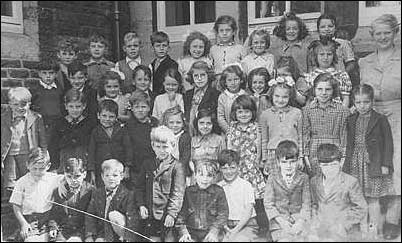 This kind of correction was part and parcel of growing up in the mid-20th
century. Being able to judge the likelihood of swift retribution for stepping
out of line became second nature. When our finely tuned survival antenna failed
us we were compensated by the pervading atmosphere of family care of which chastisement
was just another manifestation for 'your own good.'
This kind of correction was part and parcel of growing up in the mid-20th
century. Being able to judge the likelihood of swift retribution for stepping
out of line became second nature. When our finely tuned survival antenna failed
us we were compensated by the pervading atmosphere of family care of which chastisement
was just another manifestation for 'your own good.'
I am a Grangetown Boy by Jack Payne
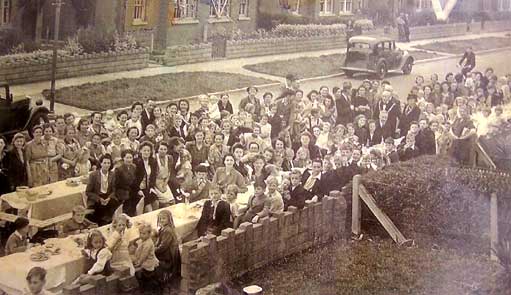
South Clive Street just after the war
| I am a Grangetown Boy Born in Pentrebane When two we moved to Amhurst Street Next to Earl Street Lane The rooms were
dark and damp My father's name was David It was the days of great Depression Men gathered on the Marl |
The Forge Pub across the road was held with great affection Because Mam played the piano there For a welcome penny collection I remember an election then
Our next move was to Clive Empire Day in school
Our future then took a turn |
We played in
street and on the Marl Rode bikes down the subway Swam in Taff Built dams of mud and jumped off Windsor Slipway Then came the war Sid Radford Special Constable
The night of Jan the second
|
| We moved then to Oakley Street On a coalman's horse and cart To rooms dark and dingy Not what you'd call smart.
Our home was then a room |
Vinegar in barrels Carried by horse and trailer Blocks of salt two feet square Sold by Salto Taylor
Pugsley walked the streets of Grange
Sid Lewis the Bookmaker |
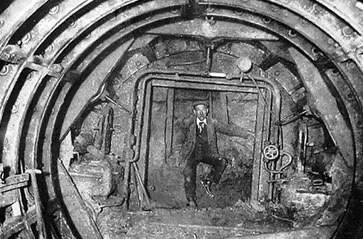 The subway under the Ely Bombs fell down, incendiaries too Since I moved away |
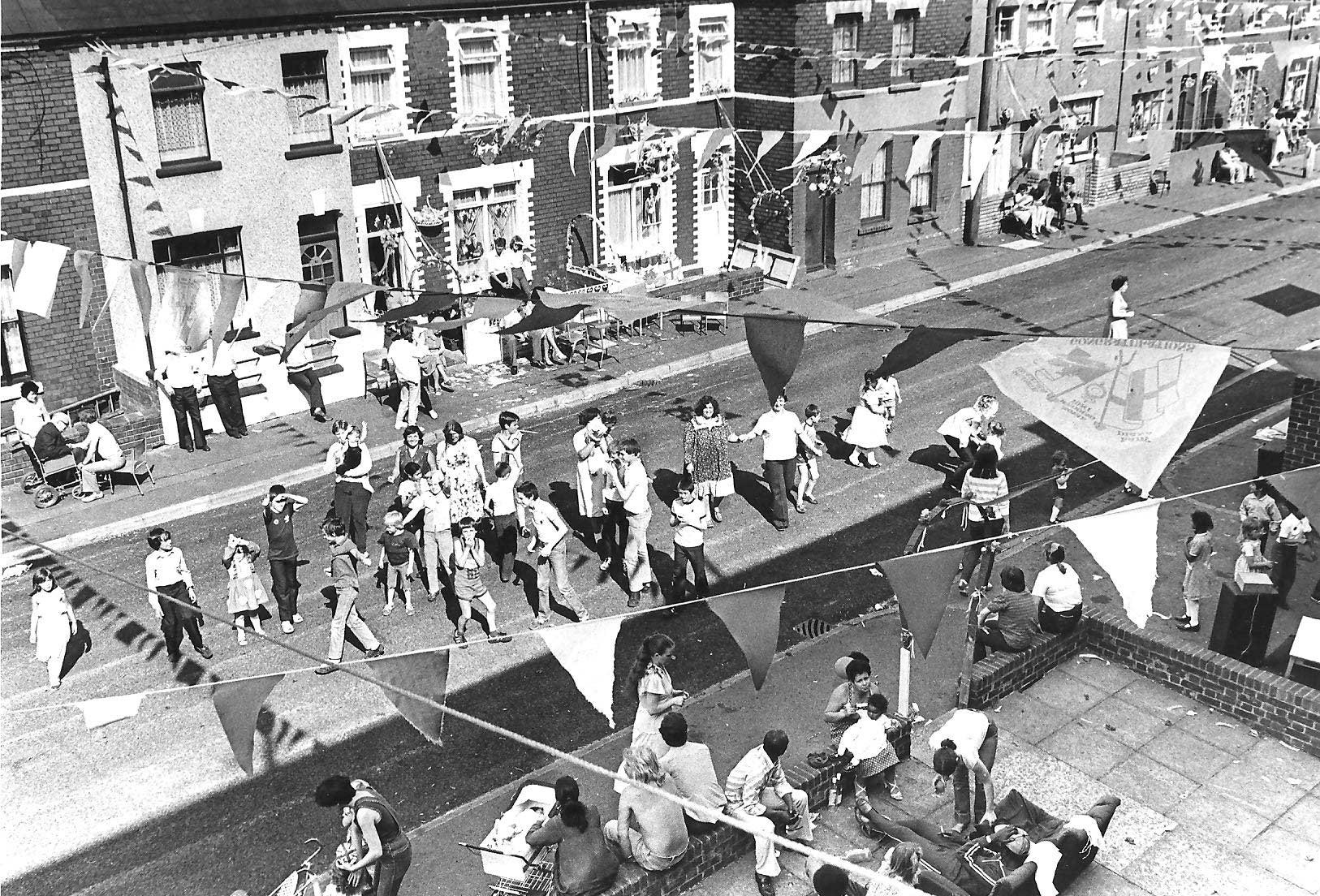
This street party in Allerton Street was in the summer of 1981 to mark the royal wedding between Prince Charles and Diana Spencer. The elevated view was from the Elizabeth flats, which have been demolished and replaced by new homes.
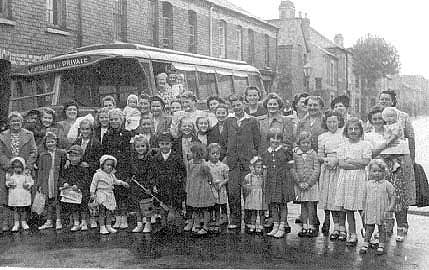 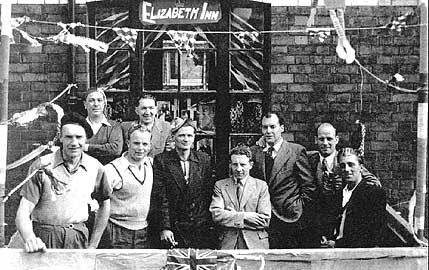
|
| LLANMAES STREET - PARTIES THROUGH
THE AGES!
By Rita Spinola
(nee Stevens) When I grew up, was married with three children, my friend Dolly and I decided to run bus outings in the August holidays. We had two for children - to Porthcawl and Weston-super-Mare and in September for the adults. Dolly and I did 13 street parties - each time they got better and better, with bouncy castle, cakes, tea, fancy dress, buffet and dancing til midnight.
Pictured above, top left- a street outing, possibly from 1949
and right of that, the "Elizabeth Inn," a makeshift bar for the Coronation
celebrations. Pictured below left is the VE anniversary party in 1995,
then below centre is a trip to Weston in 1996. Below right is the
most recent street party in 2002 to mark the Queen's golden jubilee
- children and adults wore specially-printed T-shirts with Llanmaes
Street on them.
|
SCHOOLDAYS IN THE LATE 1940s
Dennis Courtney, now living in south
Australia, sends this photo (left): "It would be in the late 1940s
- Mr Whickham's class at the Grangetown Council School. Most of the boys
would be in their late 60s or early 70s now. The building in the background
is the two classrooms they built in the school yard. They used to be Mr
Stuckey's and Mr Thomas's.
Not long after, Graham Ayres sent us this photo of the school's baseball
team (right), with trophies, in Grange Gardens in 1949. He's back row,
fourth from the left. Click on the photos for larger versions - let us
know if you're in the photos and have any memories!
| "GOING OVER THE BORDER" - THE GRANGETOWN TO PENARTH SUBWAY
By Jack Payne
I believe it was in the 1920s that the subway was built underneath the river Ely connecting Grangetown with Penarth Docks. I think it was made to enable dockworkers from Cardiff to access the newly formed Penarth Docks.
Prior to the war our family often frequented the area beyond South Clive Street
leading to the subway because for some time my mother Peggy was the pianist
who played in the Red House pub. Whilst my mother and father, (who played
drums) were in the pub I with my brother and sister played on the slipway
behind the pub.
During the war access to this area was denied to all who but those working
in the area and Special Constable Sid Radford, who had a shop in Paget
Street, was posted there along with one other to police the access. When
the war finished this area along with the subway was opened for public
access. The subway was used as a quick route around the rocky coastline
to Penarth beach and pier. Initially there was some person on guard at
each end of the tunnel, which sloped very steeply from the Grangetown
end to an "S" bend at the bottom and a more gradual rise to the Penarth
side. There was a naked 60-watt light bulb in the roof about every twenty
yards. The ceiling and walls were always dripping with water and when
it was first opened after the war there were plenty of stalactites and
stalagmites. The guards were there ostensibly to stop persons riding their
bicycles through the tunnel. After a few months the guards at the entrances
were removed and youths using the subway took out the light bulbs and
threw them to the bottom causing a loud explosion. For a while the authorities
replaced the light bulbs but as they were continually getting smashed
they eventually gave up. This plunged to tunnel into complete darkness
and at the bottom one could not see their hand in front of their face.
As there was nobody to stop them persons began riding their bicycles through
the subway and as they had entered in daylight they had no lights. Consequently
anyone walking in the subway had to keep a sharp ear for the sound of
swishing tyres as the bicycles would be travelling at a fast speed. Running
along the side and full length of the subway was a large pipe about a
foot in diameter. If one heard a bicycle coming, jumping onto this pipe
was the only safe refuge.
Sundays in Cardiff in the late 1940s were dead as the proverbial Dodo.
Shops, cinemas and pubs were all closed. The only places open were churches
and other places of worship. Then the Marina concert hall on Penarth Pier
opened with live talent contests for singers, comedians and musicians.
When the tide was right, you could walk around Penarth headland from
the subway to the pier. This meant there was a steady flow of teenagers
using this route on a Sunday evening. the term used by the teenagers was
"Going over the border". When the tide was up the train from Grangetown
Halt was used.
Jack's younger brother KEN PAYNE adds his memories of the Subway
from the 1950s: "This in essence was a metal tube under the River
Ely, very often it was in complete darkness.We would venture through the
darkness untill we could see the little halo of light appear telling us
we were nearing Penarth Dock.Once up in the dock you could cross the dock
gates and walk down to the pebble beach. Penarth dock had several World
War Two ships that had been mothballed which carried a great deal of interest
to us.The little pebble beach at Penarth was quite popular on nice summer
evenings. There would be lots of people taking a dip here. One of the
things that I found intriguing then were the metal stairs that used to
wind down from the cliff top,only to come to an end halfway down where
they’d fallen into disrepair. These stairs must have been a hair raising
experience even whilst in good order.When it was quiet we would pass our
time hurling rocks at the cliff face to try and bring it down, we would
be delighted at any small rock fall."
"We would also spend our time roaming around the dock looking for
scrap metal. This would consist of old nuts and bolts, off-cuts of metal
plate and any metal object we could carry. Once we thought there was a
sufficient weight it would be a case of lugging the metal back through
the subway. Then it was down to Bill Ways' scrapyard to see what we could
get. Generally we would be given a half crown or two bob - a pretty miserly
return for half a day dragging metal from Penarth to Cardiff, but we were
happy."
Under the river - the Grangetown subway
ZENA MABBS looks at the Grangetown subway, which ran under the River
Ely from late Victorian times. It's still there of course, if closed off.
Work began on the subway in 1897 using a trench and cover technique
from the Ferry Road, Grangetown end under the river at the same point
as the ferry crossing. The lowest section of the tunnel lies 11 feet
below the river. The decision to construct the Ely River Subway was
made by the chairman of the Taff Vale Railway, Arthur E. Guest. George
T. Sibbering, chief engineer of the Taff Vale Railway designed the subway.
The tender sum was £36,203 submitted by Tom Taylor, a mining quarrying
and civil engineering contractor from Pontypridd. The first cylindrical
section of the tunnel was laid on 5th July 1897 and the last on 15th
September 1899. It was opened the following year on 14th May 1900 by
Mrs. Beasley wife of the railway's general manager, replacing the earlier
rowing boat and steam ferries operating across the river. A toll keeper
collected a penny for each pedestrian but police and postmen were exempt
from charges. It cost twopence for a bicycle and fourpence for a perambulator.
Horses were allowed through but no one remembers the charge. Tolls were
abolished in 1941. The subway carried the hydraulic power line from
the power station to the coal tips at the harbour and a high pressure
water supply to fight fires at the oil storage area. My footsteps returned to the Grange today
With youth renewed I wandered at will
I looked at my hands There is a fantastic website
on the history of Penarth Docks, which includes more details about
the Ely subway and how it was built.
|
Grangetown's front line of defence?

Michael Griffiths, a former Grangetown resident recently sent the Grangetown
Local History Society a photograph of this pill box, off Penarth Road,
asking "is this going to be saved?"
Although Michael lives in Scotland he is a frequent visitor to Grangetown
and to his Grangetown family. The pill box can be found off Stuart Close,
before Penarth Road reaches the link-road fly-over. Michael also remembers
it being used as a bird hide.
Around 28,000 pill boxes were built at strategic points across the UK,
during World War II - sited at places such as road junctions and waterways.
It is estimated that 6,000 still remain today. There's a great website
devoted to the study, record and preservation of
pill boxes as well as a pill
box study group. There don't seem to be any listed for our part of
south Wales, apart from at the old aircraft base at Llandow in the Vale,
so the society is going to contact them.
THE BIRTH OF SOUTH CLIVE STREET
By Jack Payne To facilitate the move we used a handcart hired from the Gas Works, the type
used for carting coke. All the furniture we owned was piled onto this handcart.
For the first few weeks of living there we slept on the bare floor boards. At
that time along the whole length of the street houses were in various stages
of construction. Some were at the basic foundation stage, others were half built
or completed but awaiting interior decorating whilst about 20 were already occupied.
No. 81 was a three bedroom semi-detached house, the other half - number 83
- was still being completed, with interior doors and the like still to be fitted.
The other side of us, no 79, was still at the first level stage of being built
whilst directly opposite the family of O'Connors - children Billy, Dolly, Eddie,
John and Betty had been in occupation for some months.
Having moved there from living in rooms this was an area of wonderful excitement
for boys of my age and there were many of them. At first there was no watchman
on the site and as Cowboys and Indians were the in thing bows and arrows were
required. The site offered large quantities of wooden laths and string enough
to supply all the boys in Grangetown.
At the same time, as families moved in they helped themselves to sand and cement
to build garden paths for their homes. This soon resulted in a watchman, Eli,
being employed to cover from 5pm until work started the following day. The houses
were being finished at quite a fast rate and families were moving in daily.
No1 the Vernacombes, Graham later played as goalkeeper for Cardiff City; at
2 the Olsens, withson Alfie; No 4 the Buleys,Tom and Leon; 6 Barnets Alan; 8
Fearnley, no children but Charlie helped to run Cardiff Gas Boxing Club. 10
Lovell, Alan, opposite side Kazeras, Blakeys, Imperato, Leonard, Ryan, Shaw,
Preece, Sanders, back odd number side Lucas, Graham, Nicholas, Graham, Grady,
Parfit, Morgan, Parsons, Corner of Beecher Avenue, Bulpins Trevor and Vera,
Balch, other side O'Shea Paul, 63 Attley, (inserted by Emery family:)
65 Emery. "We moved out of South Clive Street in 1950 to 5 Ludlow Close. Uncle
Ned Rodd used his horse and cart to help move us all. My aunt Thelma Adams lived
at 120, with husband Albert and son John." 67 Rodd, 69 James Mavis, 71 Gill,
73 Fearnley Craig , opposite Cornish, Greedy, Perkins Malcolm and Cedric, Coles
Josey, O'Connors referred to above, James, Shelley Sylvia and Maureen, Bevan
Teddy, Stubbs Jean, Pearce Ronald, back on odd side 75 Parry Gordon and Dennis,
77 James, 79 Alloway Sylvia, Dorothy, Pam, Valerie, 81 Payne, 83 Chiplin Gladys,
Irene, Thelma, Sylvia. They had an evacuee named Rene Grinewald during the war.
85 Born, 87 Evans, 89 Swan, 91 Leigh, Maureen, they left and a family named
Hall Raymond and Tom moved in. 93 Young 95 Saunders Dennis, 97 Williams Chrissie,
99 Davis "Curly" 101 Andrews Billy he had six fingers on one hand and Stanley
"Ikey". Opposite side Guppy Graham, Johannison, Roach, Binding Barbara, Bellamy
Celia, Batten, Kennedy and others I cannot at present remember. These were the
first people to take up occupation between 1937 and 1940 many families later
enlarged by having more children.
When all the houses were finished and occupied
early 1939 they built walls all along the fronts of the houses and topped these
walls with a wrought iron fence about 18 inches high. Each house was also provided
with a wrought iron gate to their front path.. The pavement was laid in large
concrete slabs and the area between the pavement and road about five feet in
width was laid with turf. No trees were planted at that time. Soon after the
war started the gates and wrought iron fences were removed as scrap for the
war effort.
As the families moved in and removed the builders rubble from their front gardens, the majority laid the front garden to lawn. Turfs of sea grass were dug from the tide fields. These turfs made a lawn of strong wearing really tough grass. I know it was tough because it was my job to cut it with a pair of shears. No lawn mower in those days.
The depression era of the 20s and 30s spawned a generation of hardened street wise kids in Grangetown. A large number of these were domiciled in South Clive Street already toughed to withstand the shortages and perils of the coming war.
The building of the houses in South Clive
Street began in 1937. Our family then consisting of Mam and Dad, sister Hazel,
eight, two-year-old brother and myself aged five, moving into number 81 in the
spring of 1938.

VE Day celebrations at the top end of South Clive Street in May 1945.
Pic: Jack Payne.
